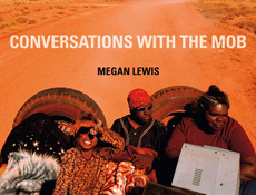 | Megan Lewis CONVERSATIONS WITH THE MOB University of Western Australia Press, 240 pp. Source: review copy Review by Michael Freedman |
Photojournalism is, in essence, the collection of images to tell a story. It is sometimes said that photojournalists capture verbs, while mere photographers capture nouns. What photojournalists actually capture is moments in time, presenting those moments in a way that evokes emotion in the viewer and invokes insight about the subject. In Conversations with the Mob, award-winning photojournalist Megan Lewis documents a five-year mission to tell the story of the Martu, an Aboriginal people of the Western Desert in Western Australia. In doing so, she learns as much about herself as she does about her subjects. I suspect the reverse is also true.
Born and raised in rural New Zealand, Megan Lewis moved to Australia when she was 21. Ten years later, in 2002 (the same year the Federal Court granted the Martu people native title of 136,000 square kilometres of desert land) she decided to quit her job as a photographer for The Australian and live in the desert with the Martu people, affectionately referred to throughout the book, often by the Martu themselves, as "the mob". The goal: to write a book comprising a series of photographs telling the story of an indigenous people in some ways far removed from non-indigenous culture, but in other ways tragically affected by the worst parts of it. In doing so, Ms Lewis hoped to assist understanding of the ways of the Martu. Ms Lewis' book will also hopefully facilitate non-indigenous Australians' understanding of themselves, and the consequences of their actions.
After the first three months of her odyssey, Ms Lewis, in her own words, "hit the wall". The isolation, the heat (50 degree days being the norm) and the insects combined to severely test Ms Lewis' resolve. After some serious soul-searching, Ms Lewis decided to forget her preconceived expectations, and live "completely in the moment". This allowed Ms Lewis to not only accept her situation, but also allowed the Martu to accept her as well.
The book itself canvasses a number of themes -- alienation from and lack of understanding by the white Government, loss of culture stemming from the impact of non-indigenous beliefs, and preventable deaths from European diseases and access to alcohol, cigarettes and an unhealthy diet. But it also delivers (if you'll pardon the pun) a fascinating snapshot into the culture of one of Australia's indigenous peoples. From the Martus' occasional mistrust of the "whitefella" but more usual bemusement at his behaviour, to Martu beliefs in maparn (healing) and jukartani (dreamtime), Conversations with the Mob provides insight into a culture that has as many similarities with non-indigenous culture as there are differences. The Martu devotion to their children, love and significance of sport and pop culture, and the importance of solid inter-personal relationships are pervasive themes. But so is Ms Lewis' integration into a culture that accepted her with little reservation.
The book's colour glossy photos are many and varied, and show the Martu people in all their guises -- male and female, young and old, at work and play, happy and grieving. Ms Lewis has a discerning eye for a photograph, and as a photojournalist maintains a sense of objectivity that must have become increasingly difficult the more she got to know her subjects. Indeed, the closeness of the friendships made by Ms Lewis with the Martu people is made clear in the book, which is lovingly constructed by someone who was obviously deeply affected by the subject matter. In addition to capturing verbs, Ms Lewis has captured the hearts of a people who have every reason to be suspicious of a "whitefella" with a camera.
